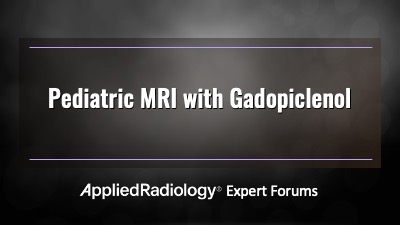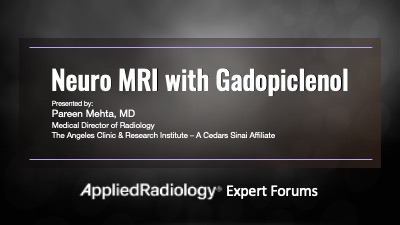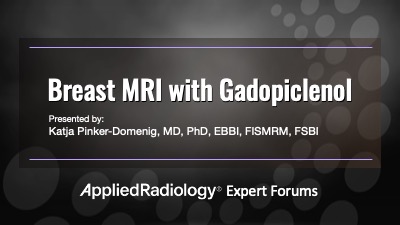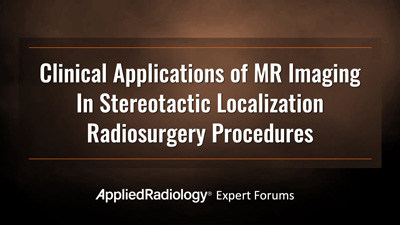 Body MRI with Gadopiclenol Body MRI with Gadopiclenol
Bachir Taouli, MD MHA
Credits: 1.0 Category A, ARRT credit | 1.0 AHRA CRA credit • Effective Date: Jan. 14, 2025 • Expiration Date: Feb. 29, 2028
While gadolinium-based contrast agents (GBCAs) are essential to performing MR imaging, guidance from the US Food and Drug Administration (FDA) and the American College of Radiology (ACR) includes the recommendation of limiting a patient's gadolinium exposure. One technique for reducing gadolinium exposure is to use a high-relaxivity gadolinium-based contrast agent (GBCA) that can be administered at a lower dose than a conventional GBCA without negatively impacting image quality. Gadopiclenol is an FDA-approved, macrocyclic, high relaxivity GBCA that reveals high-quality images at half the conventional dose of other GBCAs and is approved for body MRI applications.
This educational program provides the clinical rationale for adopting the use of Gadopiclenol for Body MRI.
Through case study reviews, Bachir Taouli MD, will share clinical insights to achieve optimal image quality using a lower administered gadolinium dose during body MRI. A focus on the safety, selection and utilization of a high relaxivity, lower dose GBCA will be supported by clinical evidence and imaging protocols. Audience participation will be encouraged during the Q & A session following the presentation.
Learning Objectives
At the conclusion of this activity, participants should be able to:
-
State the properties of the FDA-approved GBCAs (gadolinium-based contrast agents).
-
Understand the clinical risks and safety considerations of GBCA selection and utilization.
-
Implement the use of Gadopiclenol in Body MRI applications.
Commercial Support
This program has been supported by Guerbet LLC.
To view the program and complete the Post-Exam and claim credits select Profession below.
(Site Registration/Login Required)
 Pediatric MRI with Gadopiclenol Pediatric MRI with Gadopiclenol
Azam Eghbal, MD
Credits: 1.0 Category A, ARRT credit | 1.0 AHRA CRA credit • Effective Date: Oct. 16, 2024 • Expiration Date: Oct. 31, 2027
While gadolinium-based contrast agents (GBCAs) are essential to performing MR imaging, guidance from the US Food and Drug Administration (FDA) and the American College of Radiology (ACR) includes the recommendation of limiting a patient's gadolinium exposure. One technique for reducing gadolinium exposure is to use a high- relaxivity gadolinium-based contrast agent (GBCA) that can be administered at a lower dose than a conventional GBCA without deteriorating image quality. Gadopiclenol recently approved by the FDA is a high-relaxivity GBCA, designed to reveal high-quality images at half the conventional dose of other GBCAs.
This educational program provides the clinical rationale for adopting the use of Gadopiclenol for pediatric MRI.
Through case study reviews, Azam Eghbal, MD, will share clinical insights to achieve optimal image quality using a lower administered gadolinium dose when performing pediatric MRI. A focus on the selection and use of a high relaxivity, lower dose GBCA in vulnerable patients, receiving multiple MR contrast injections, will be supported by clinical evidence and imaging protocols. Audience participation will be encouraged during the Q & A session following the presentation.
Learning Objectives
At the conclusion of this activity, participants should be able to:
-
Explain the properties that distinguish gadopiclenol from other GBCAs.
-
Apply clinical considerations for lower gadolinium dosing options using gadopiclenol for pediatric MRI.
-
Implement gadopiclenol MR imaging protocols to achieve optimal imaging and diagnostic confidence in pediatric MRI.
-
Employ the use of gadopiclenol in vulnerable patient populations who may experience repeat, lifetime dosing and scanning.
Commercial Support
This program has been supported by Guerbet LLC.
To view the program and complete the Post-Exam and claim credits select Profession below.
(Site Registration/Login Required)
 Neuro MRI with Gadopiclenol Neuro MRI with Gadopiclenol
Pareen Mehta, MD
Credits: 1.0 Category A, ARRT credit | 1.0 AHRA CRA credit • Effective Date: Oct. 8, 2024 • Expiration Date: Oct. 31, 2027
While GBCAs are essential to performing neuro MR imaging, guidance from the US Food and Drug Administration (FDA) and the American College of Radiology (ACR) includes the recommendation of limiting a patient's gadolinium exposure
One technique for reducing gadolinium exposure is to use a high-relaxivity gadolinium-based contrast agent (GBCA) that can be administered at a lower dose than a conventional GBCA without deteriorating image quality. Gadopiclenol, recently received FDA approval and is a high-relaxivity GBCA, designed to generate high-quality images at half the conventional dose of other GBCAs
This educational program provides the clinical rationale for adopting the use of Gadopiclenol for neuro MRI and includes practice considerations for changing from one GBCA to another.
Through case study reviews, Pareen Mehta, MD, will share clinical insights into achieving optimal image quality using a lower administered gadolinium dose when performing neuro MRI.
Learning Objectives
At the conclusion of this activity, participants should be able to:
-
Understand and employ the clinical indications for neuro MRI using gadopiclenol.
-
Apply clinical considerations for lower neuro MRI gadolinium dosing protocols as compared to other GBCAs in neuroradiology.
-
Utilize neuro MR imaging protocols using gadopiclenol to achieve optimal image quality and diagnostic confidence.
Commercial Support
This program has been supported by Guerbet LLC.
To view the program and complete the Post-Exam and claim credits select Profession below.
(Site Registration/Login Required)
 Breast MRI with Gadopiclenol Breast MRI with Gadopiclenol
Katja Pinker-Domenig, MD, PhD, EBBI, FISMRM, FSBI
Credits: 1.0 Category A, ARRT credit | 1.0 AHRA CRA credit • Effective Date: July 18, 2024 • Expiration Date: July 31, 2027
Dynamic contrast-enhanced breast MR imaging using gadolinium-based contrast agents (GBCAs) offers superior cancer detection to mammography and breast ultrasound due to the visualization of tumor neovascularity as a tumor-specific feature. Despite the clear advantages of breast MR imaging, it is currently recommended only for patients with a high lifetime risk of breast cancer, but recent data shows that there is also a benefit for women at a greater than average risk.
While GBCAs are essential to performing breast MR imaging, guidance from the US Food and Drug Administration (FDA) and the American College of Radiology (ACR) includes the recommendation of limiting a patient's gadolinium exposure where possible. One technique for reducing gadolinium exposure is to use a high-relaxivity GBCA that can be administered at a lower dose than a conventional GBCA without deteriorating image quality. Gadopiclenol recently received FDA approval and is a high-relaxivity GBCA that decreases gadolinium exposure.
This educational program provides a clinical rationale for lowering the administered gadolinium dose when performing breast MRI on patients who may receive repeat MR contrasted exams throughout their lifetime for breast cancer screening. Through a review of case studies, Dr. Pinker-Domenig will provide insight on how to achieve optimal imaging while lowering the gadolinium dose with Gadopiclenol for breast MRI.
Learning Objectives
At the conclusion of this activity, participants should be able to:
-
Understand and employ the clinical indications for dynamic-contrast enhanced breast MRI.
-
Access clinical considerations and apply lower gadolinium dosing options for patients who may experience repeat, lifetime dosing of a GBCA for breast MRI.
-
Implement breast MR imaging protocols to achieve the most accurate breast cancer diagnosis.
Commercial Support
This program has been supported by Guerbet LLC.
To view the program and complete the Post-Exam and claim credits select Profession below.
(Site Registration/Login Required)
 Clinical Applications of MR Imaging in Stereotactic Localization Radiosurgery Procedures Clinical Applications of MR Imaging in Stereotactic Localization Radiosurgery Procedures
Jenny WU, MD and Glen Stevens, DO, PhD
Estimated time for completion: 1.5 hours • Date of Release: January 2, 2024 • Expiration Date: January 31, 2027
Gadolinium-based contrast agents (GBCAs) are essential for enhancing the quality of MRI scans to make it easier for radiologists to identify pathology. The US Food and Drug Administration (FDA) and the American College of Radiology (ACR) recommend limiting patient exposure to gadolinium where possible. One technique for reducing this exposure is to use a high relaxivity GBCA that can be administered at a lower dose than a conventional GBCA, without any impact on image quality. GBCA selection for interventional procedures such as radiosurgery is one such example, where the selection of a GBCA can play a role in patient management and outcomes.
In this CME/CE accredited Expert Forum webinar, an experienced neuroradiologist and neuro oncologist will present their clinical experiences with the use of stereotactic localization radiosurgery, following the administration of a high relaxivity GBCA. Through case study examples, the clinical impact of contrast selection will be demonstrated. Following the presentation, questions from the audience will be addressed during a live Q&A.
Learning Objectives
At the conclusion of this activity, participants should be able to:
-
Review the role of stereotactic radiosurgery (SRS) for brain metastases and the role of pre-operative localization MRI exams for stereotactic radiosurgery.
-
Outline the differences between gadopiclenol and other group II gadolinium-based contrast agents.
-
Discuss the use of gadopiclenol in specific case-based scenarios for stereotactic localization exams and its impact on patient management.
Accreditations
This activity has been planned and implemented in accordance with the accreditation requirements and policies of the Accreditation Council for Continuing Medical Education (ACCME) through the joint providership of IAME and Anderson Publishing. IAME is accredited by the ACCME to provide continuing medical education for physicians. IAME designates this internet live activity for a maximum of one and a half (1.5) AMA PRA Category 1 Credits™.
This course meets all criteria and has been approved by the AHRA, The Association for Medical Imaging Management and the CRA for one and a half (1.5) ARRT Category A CE Credit.
Commercial Support
This program is made possible through an unrestricted educational grant from Guerbet.
To view the program and complete the Post-Exam and claim credits select Profession below.
(Site Registration/Login Required)
 Clinical Applications & Imaging Considerations of Gadopiclenol Injection Clinical Applications & Imaging Considerations of Gadopiclenol Injection
Lawrence Tanenbaum, MD, FACR
Estimated time for completion: 1.0 hour • Date of Release: May 10, 2023 • Expiration Date: March 31, 2026
In September 2022, Gadopiclenol injection, which is both macrocyclic (stable) and has high relaxivity properties received FDA marketing approval and may provide dosing options that can decrease gadolinium exposure, particularly in vulnerable patients
In this accredited Expert Forum webinar, the assessment of Gadopiclenol injection in neuro, body, and pediatric MR imaging will be presented by a panel of MR imaging experts and will include commentary from Lawrence N. Tanenbaum, MD. To encourage audience participation, a live Q & A session will follow the discussion.
Learning Objectives
At the conclusion of this activity, participants should be able to:
-
Explain the properties that distinguish Gadopiclenol injection from the other high-relaxivity and conventional gadolinium-based contrast agents.
-
Describe the clinical use of Gadopiclenol injection in neuro, body, and pediatric MRI applications.
-
Describe the clinical development program of Gadopiclenol injection for neuro and body MRI applications.
-
Apply clinical considerations and dosing options when selecting a macrocyclic, high relaxivity, MRI contrast in vulnerable patient populations.
Accreditation
This course is approved by the The Association for Medical Imaging Management (AHRA) for 1.0 "Category A" ARRT and CRA continuing education credit.
Commercial Support
This program has been supported by Guerbet LLC.
To view the program and complete the Post-Exam and claim credits select Profession below.
(Site Registration/Login Required)
 Development and Use of Elucirem (gadopiclenol) injection, a Macrocyclic, High-Relaxibity GBCA for CE-MRI Development and Use of Elucirem (gadopiclenol) injection, a Macrocyclic, High-Relaxibity GBCA for CE-MRI
Lawrence Tanenbaum, MD, FACR; Laurie A. Loevner, MD; Donna Roberts, MD; Jeffrey Weinreb, MD; Ahmed Abdelal, PharmD
Estimated time for completion: 1.0 hour • Date of Release: February 24, 2023 • Expiration Date: March 31, 2026
After decades of administrations, substantial evidence has accumulated for the efficacy and safety of gadolinium-based contrast agents (GBCAs) in magnetic resonance imaging (MRI). However, their excellent performance has led to increased use and dosing for many neuro and cardiovascular applications in adults and children.
As a result, concern has been growing in the radiology community, particularly with respect to use of the less stable agents, which are generally linear and, therefore, bind less tightly to the gadolinium (Gd) ion. While recognizing the value of these agents, the US Food and Drug Administration (FDA) and the American College of Radiology (ACR) now recommend limiting patient Gd exposure where possible. One technique for reducing Gd exposure is to use a high-relaxivity
One technique for reducing Gd exposure is to use a high-relaxivity GBCA that can be used at a lower dose than a conventional GBCA without impact on image quality. Until recently, however, the GBCA with the highest relaxivity was a linear agent. Consequently, it has been widely recognized for some time that it would be preferable if a GBCA was both macrocyclic in structure and high relaxivity, and that such an agent could be used to reduce Gd exposure by decreasing the amount of Gd injected.
A new GBCA that is both macrocyclic and high relaxivity has been developed and received FDA marketing approval in September 2022. A group of radiologists with extensive experience in contrast-enhanced (CE)-MRI convened to discuss this new GBCA, Elucirem™ (gadopiclenol) injection, and this monograph presents a summary of this expert panel forum.
Learning Objectives
At the conclusion of this activity, participants should be able to:
-
Describe the distinguishing properties of the available gadolinium-based contrast agents (GBCAs) currently used for magnetic resonance imaging (MRI);
-
Review how the structure of the gadolinium (Gd)-chelate complex determines the stability of a GBCA, and how stability relates to both Gd retention and nephrogenic systemic fibrosis (NSF);
-
Explain what a “high-relaxivity” GBCA is and summarize results of crossover studies comparing standard- and high-relaxivity GBCAs for MRI;
-
State the key considerations when selecting a GBCA for neuro MRI, pediatric MRI, body MRI, and breast MRI.
Accreditation
This course is approved by the The Association for Medical Imaging Management (AHRA) for 1.0 "Category A" ARRT continuing education credit.
Commercial Support
This program has been supported by Guerbet LLC.
To view the program and complete the Post-Exam and claim credits select Profession below.
(Site Registration/Login Required)
|
|
|